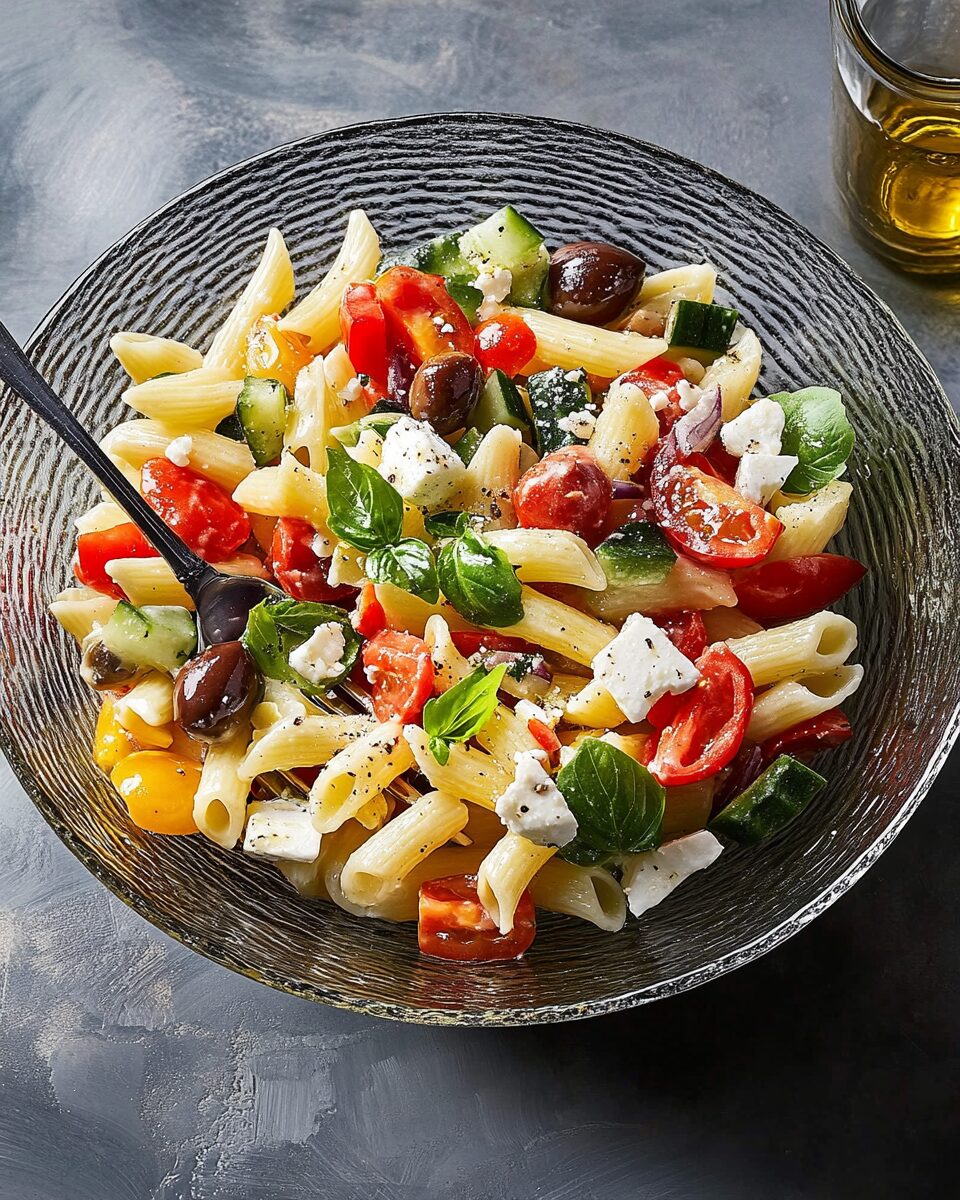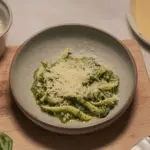The classic flavors of a Greek salad meet hearty penne pasta in this Mediterranean-inspired dish. Packed with crisp bell peppers, juicy cherry tomatoes, sliced cucumbers, tangy black olives, and creamy feta, it’s all tossed in a punchy red wine vinaigrette that brings it all together. Whether you’re prepping for a summer potluck, a weekday lunch, or a no-fuss family dinner, this Greek Pasta Salad checks all the boxes. It’s colorful, fresh, and versatile—you can serve it as a main or a side, and it gets even better after chilling. Add some grilled chicken or chickpeas for extra protein if you like!
Full recipe:
Ingredients:
-
2 cups penne pasta
-
⅔ cup extra-virgin olive oil
-
¼ cup red wine vinegar
-
2 cloves garlic, crushed
-
1 tablespoon lemon juice
-
2 teaspoons dried oregano
-
Salt and pepper to taste
-
10 cherry tomatoes, halved
-
1 green bell pepper, chopped
-
1 red bell pepper, chopped
-
1 small red onion, chopped
-
½ cucumber, sliced
-
½ cup sliced black olives
-
½ cup crumbled feta cheese
Directions:
-
Bring a large pot of salted water to a boil. Add penne pasta and cook until al dente, about 10 minutes. Drain and rinse with cold water.
-
In a bowl, whisk together olive oil, red wine vinegar, crushed garlic, lemon juice, oregano, salt, and pepper. Set the vinaigrette aside.
-
In a large mixing bowl, combine the cooked penne, halved cherry tomatoes, chopped green and red bell peppers, red onion, cucumber, olives, and crumbled feta cheese.
-
Pour the vinaigrette over the pasta mixture and toss until well coated.
-
Cover and refrigerate for at least 1 hour before serving to allow the flavors to meld.
Prep Time: 15 minutes | Cooking Time: 10 minutes | Total Time: 25 minutes
Kcal: 307 kcal | Servings: 8 servings
The Ultimate Greek Pasta Salad: A Mediterranean Classic With a Modern Twist
Greek Pasta Salad is one of those timeless dishes that effortlessly combines fresh, wholesome ingredients with bold, tangy Mediterranean flavors. It’s refreshing, hearty, versatile, and incredibly easy to prepare. Whether you’re planning a summer picnic, a quick weekday lunch, or a vibrant side dish for a family gathering, this pasta salad is your go-to option.
In this article, we’ll explore the origins of Greek pasta salad, dive into the key ingredients and their benefits, offer preparation and storage tips, and suggest creative ways to customize it to suit your preferences. This isn’t just another pasta salad—it’s a recipe rooted in simplicity and flavor that continues to win hearts around the world.
Origins and Inspiration of Greek Pasta Salad
While traditional Greek salad (or “Horiatiki”) doesn’t include pasta, Greek Pasta Salad is a modern adaptation popularized in Western kitchens, especially in the United States and Australia. It’s inspired by the classic Greek salad components—tomatoes, cucumber, onion, olives, and feta—but adds pasta to transform the dish from a side into a satisfying main.
The dish embraces the best of the Mediterranean diet: fresh produce, olive oil, and simple seasonings. It captures the essence of Greek cuisine—minimalistic yet bursting with flavor—and showcases how ingredients like oregano, lemon, and vinegar can elevate a humble bowl of pasta.
Nutritional Benefits of Greek Pasta Salad
One of the standout features of this dish is its nutritional profile. Here’s why it earns a spot on your weekly meal plan:
- Olive Oil: Rich in heart-healthy monounsaturated fats and antioxidants, extra virgin olive oil supports cardiovascular health and adds a luscious mouthfeel to the salad.
- Vegetables: Bell peppers, cucumbers, tomatoes, and onions offer fiber, vitamins C and A, potassium, and plenty of hydration.
- Feta Cheese: A good source of calcium and protein, feta also brings in probiotics which support gut health.
- Whole Ingredients: The salad is naturally gluten-free if you opt for gluten-free pasta and can be made dairy-free or vegan with easy swaps.
It’s light enough for a summer lunch yet filling enough to be a complete meal. Plus, with no mayo or cream-based dressing, it’s a healthier alternative to traditional pasta salads.
What Makes This Greek Pasta Salad the Best?
Several key details elevate this particular recipe:
- Perfect Dressing Balance: The vinaigrette uses red wine vinegar, lemon juice, garlic, and dried oregano—a zesty, aromatic blend that pairs beautifully with feta and olives.
- Chilling Time Enhances Flavor: Letting the salad chill in the fridge allows the pasta to absorb the dressing, intensifying the overall flavor.
- Customizable Texture: The mix of crunchy vegetables and tender pasta creates a satisfying mouthfeel, while the crumbled feta adds a creamy contrast.
It’s a foolproof recipe that’s easy for beginners but nuanced enough for seasoned home cooks to appreciate.
Best Pasta Types for the Salad
Penne is the classic choice for this recipe, but you’re not limited to it. Here are other pasta shapes that work equally well:
- Rotini: Great for holding onto the dressing.
- Fusilli: Similar to rotini but slightly tighter spirals.
- Orzo: Makes the dish feel more like a grain salad.
- Bowtie (Farfalle): Adds visual appeal and a satisfying bite.
The key is to use pasta that can absorb and hold the vinaigrette without becoming soggy.
Ingredient Substitutions and Additions
This Greek Pasta Salad is extremely versatile. Here are some popular additions and swaps:
-
Additions:
- Chickpeas or white beans for added protein
- Artichoke hearts for a tangy twist
- Grilled chicken or shrimp to turn it into a complete meal
- Fresh herbs like dill, parsley, or mint
-
Substitutions:
- Use kalamata olives for more authentic Greek flavor
- Swap red onion with green onion or shallots for milder taste
- Replace feta with goat cheese or a dairy-free alternative for vegan diets
- Use tri-color pasta for a more colorful presentation
Make-Ahead and Storage Tips
One of the most convenient aspects of this recipe is its make-ahead potential. In fact, it tastes better the next day!
- Refrigeration: Store the salad in an airtight container for up to 3–4 days.
- Meal Prep: Ideal for weekly lunches—just portion into meal prep containers.
- Avoid Soggy Pasta: Drain pasta well after cooking, and toss with a little oil to prevent sticking if preparing ahead of time.
- Keep Dressing Separate: For even better texture, keep the dressing separate until just before serving if making it a day in advance.
How to Serve Greek Pasta Salad
This dish is incredibly versatile when it comes to serving options:
- As a Main: Serve it in a large bowl with extra feta on top, a few lemon wedges, and toasted pita on the side.
- As a Side: Pairs perfectly with grilled meats, kebabs, or seafood.
- On a Platter: Arrange ingredients separately for a deconstructed presentation, perfect for buffets or potlucks.
- In Jars: A fun and portable way to serve this at picnics or road trips.
Kid-Friendly and Crowd-Pleasing
While it’s packed with vegetables, the mild, zesty dressing and the familiar taste of pasta make this recipe very kid-friendly. Many parents find it a great way to introduce little ones to new flavors like olives or feta. It’s also a hit at potlucks, BBQs, and summer parties. It’s vegetarian, colorful, and can be adapted to most dietary preferences—something not every dish can claim.
Pairing Suggestions
If you’re serving Greek Pasta Salad as part of a larger spread, here are a few pairing ideas:
- Protein: Grilled chicken souvlaki, lamb chops, falafel, or pan-seared halloumi
- Breads: Warm pita bread, garlic knots, or crusty baguette
- Drinks: Pair with iced tea, white wine like Sauvignon Blanc, or a sparkling lemon water
Tips for Maximum Flavor
- Use Fresh Ingredients: Fresh tomatoes, crisp cucumbers, and real Greek feta will always yield the best flavor.
- Let It Marinate: Even 30 minutes in the fridge allows the dressing to soak in and the flavors to marry beautifully.
- Don’t Overcook Pasta: Al dente is ideal—it keeps the salad from getting mushy.
- Taste and Adjust: Always taste before serving. You may want to add a pinch more salt, an extra squeeze of lemon, or a drizzle of olive oil.
A Versatile Dish for Every Season
Though it’s typically associated with summer, Greek Pasta Salad fits seamlessly into all seasons. Serve it warm in fall with roasted vegetables, or chilled in spring and summer for a refreshing bite. Its ingredients are available year-round, making it a reliable favorite in any month.
Conclusion
Greek Pasta Salad is more than just a simple side dish—it’s a flavorful, wholesome, and vibrant representation of Mediterranean cooking. With the perfect balance of texture, taste, and nutrition, it’s no wonder this recipe continues to appear at dinner tables and potlucks around the globe. It’s a salad that can evolve with your preferences and adapt to whatever ingredients you have on hand. Make it your own, enjoy it chilled or warm, and share it with friends and family. It’s one of those rare recipes that’s as enjoyable to prepare as it is to eat.






